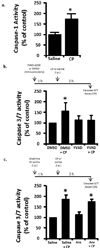Cyclophosphamide Induces an Early Wave of Acrolein-Independent Apoptosis in the Urothelium
- PMID: 24353901
- PMCID: PMC3864667
- DOI: 10.4236/abb.2013.48A2002
Cyclophosphamide Induces an Early Wave of Acrolein-Independent Apoptosis in the Urothelium
Abstract
Purpose: Hemorrhagic cystitis (HC or bladder inflammation) affects a significant number of patients undergoing cyclophosphamide (CP) chemotherapy despite treatment with 2-mercaptoethane sulfonate (Mesna) to inactivate the metabolite acrolein. While the mechanism is unknown, there is clearly acrolein-independent damage to the urothelium. In this study we have explored the induction of apoptosis in the urothelium as a marker of damage and the mechanism underlying the acrolein-independent apoptosis.
Materials and methods: Apoptosis in urothelium (caspase-3/7 activity and Poly (ADP-ribosyl) polymerase (PARP) cleavage) was measured following CP administration (80 mg/kg). Sodium 2-mercaptoethane sulfonate (Mesna) was used to mask acrolein's effect. An IL-1β receptor antagonist and a cell-permeable caspase-1 inhibitor were used to assess the involvement of IL-1β and caspase-1, respectively.
Results: Two waves of apoptosis were detected following CP administration, one peaking at 2 h and a second at 48 h. The first wave was independent of acrolein. Caspase-1 was also active at 2 h and activation of caspase-3/7 was blocked by a caspase-1 inhibitor but not an IL-1β receptor antagonist suggesting the direct activation of caspase-3/7 by caspase-1 without the need for IL-1β as an intermediate.
Conclusions: Our results indicate that CP initiates an early, acrolein-independent wave of apoptosis that results from direct cleavage of caspase-3/7 by caspase-1.
Keywords: Apoptosis; Bladder; Cyclophosphamide; Cystitis; Urothelium.
Conflict of interest statement
Figures



References
-
- Hu RQ, Mehter H, Nadasdy T, Satoskar A, Spetie DN, Rovin BH, Hebert L. Severe hemorrhagic cystitis associated with prolonged oral cyclophosphamide therapy: case report and literature review. Rheumatol Int. 2008;28(11):1161–1164. - PubMed
-
- Haselberger MB, Schwinghammer TL. Efficacy of mesna for prevention of hemorrhagic cystitis after high-dose cyclophosphamide therapy. Ann Pharmacother. 1995;29(9):918–921. - PubMed
-
- Cesaro S, Hirsch HH, Faraci M, Owoc-Lempach J, Beltrame A, Tendas A, Baltadakis I, Dalle JH, Koc Y, Toporski J, Styczynski J, Yesilipek MA, Heinz W, Caniglia M, Rascon J, Fauser AA, Michallet M, Lopez-Corral L, Neuburger S, Tridello G, Einsele H. Cidofovir for BK virus-associated hemorrhagic cystitis: a retrospective study. Clin Infect Dis. 2009;49(2):233–240. - PubMed
-
- Harkensee C, Vasdev N, Gennery AR, Willetts IE, Taylor C. Prevention and management of BK-virus associated haemorrhagic cystitis in children following haematopoietic stem cell transplantation--a systematic review and evidence-based guidance for clinical management. Br J Haematol. 2008;142(5):717–731. - PubMed
Grants and funding
LinkOut - more resources
Full Text Sources
Other Literature Sources
Research Materials
Miscellaneous
